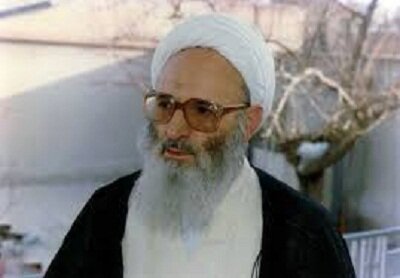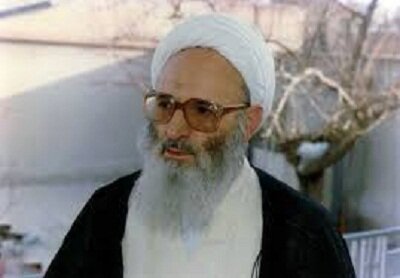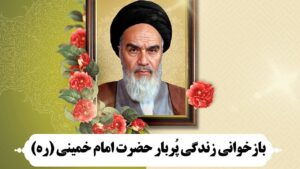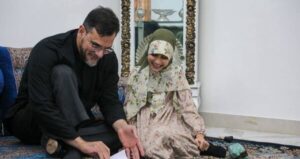
Allameh Hassan Hassanzadeh Amoli (1307-1400), known as Allameh Hassanzadeh Amoli, was a Shiite philosopher and mystic. He studied with people such as Mehdi Elahi Qomshaei, Allameh Shearani, Allameh Tabatabai and Seyed Mohammad Hasan Elahi.
An excerpt from Zangi’s introduction and the works of this contemporary scholar in Missionary thought and culture base You read:
Hassanzadeh Amoli received the permission of ijtihad and the permission to recite hadith from Allameh Shearani. He taught philosophical and mystical works such as Asharat, Asfar Arba’ah, and Commentary on the Caesarian Poems and Manzomeh, as well as mathematics and board.
According to Hassanzadeh Amoli, religion, philosophy and mysticism are in harmony with each other. He considers the claim of the Greekness of Islamic philosophy to be incorrect and believed that Muslim philosophers deepened the thoughts of pre-Islamic philosophers. According to Seyyed Yadullah Yazdan Panah, among his students, Hassanzadeh received the most influence from Mulla Sadra and Ibn Arabi. For the first time, he interpreted the personal unity of existence as Tawhid Samadi and used the word Samad in Surah Tawheed to prove it.
Hasanzadeh Amoli has works in philosophy, mysticism, mathematics, astronomy, Persian literature and Arabic literature, and he has corrected some philosophical and mystical works such as Asfar Arba’ah, Asharat, Shafa and Sharah Foss al-Hakm, and has written commentary and margins on them. He has also corrected Nahj al-Balagha and Kashf al-Murad. He also left a collection of poems.
Allameh Hassanzadeh Amoli died on 3 Mehr 1400 AH (18 Safar 1443 AH) in Amol due to a heart disease and was buried in his personal home in Ira village, Amol suburbs.
Biography and education
Hassan Hassanzadeh Amoli was born at the end of 1307, in the village of Ira, in Amol district. At the age of six, he learned to read and write in the school and in 1323 he started seminary lessons. He learned Arabic literature and introductory lessons in Amol from Mohammad Gharavi, Mirza Abulqasem Farsiu and others.
Migration to Tehran
Hassanzadeh Amoli, after completing the preparatory courses of the seminary, put on the clothes of the clergy and entered Tehran at the age of 22 to continue his education. In Tehran, he learned jurisprudence and principles from people such as Seyyed Ahmad Lavasani, Abolhasan Shearani, Seyed Abolhasan Rafiei Qazvini and Mohammad Taghi Amoli, and he also learned philosophy and mysticism from Mahdi Elahi Qomshaei, Allameh Shearani, Fazel Toni, Mirza Ahmad Ashtiani and Ali Mohammad Julestani. Hasanzadeh also learned Tafsir, Rijal, Darayah, Mathematics, Hadith, Astronomy, and Medicine from Allameh Shearani, and in 1393 AH, he received permission for ijtihad and permission to recite hadith. For 11 years, he studied Sabzevari’s “Manzomeh” with Mahdi Elahi Qomshaei, parts of Asfar and Mohaghegh Tusi’s commentary on Asharat, and attended his Qur’an interpretation sessions.
Migration to Qom
Hassanzadeh Amoli, after studying in Tehran for fourteen years, went to Qom in Mehr 1342 and attended the lessons of Allameh Tabatabai for 17 years. During this time, he read parts of Bihar al-Anwar and Tahmhid al-Qasas with him. He also participated in the philosophical and mystical lessons of Seyyed Mohammad Hasan Elahi, the brother of Allameh Tabatabai. Seyyed Mahdi Ghazi Tabatabai, son of Sayyed Ali Ghazi, was his teacher in arithmetic sciences for four years.[یادداشت ۱] was According to Hassanzadeh’s memoirs in the book “Insan Dar Araf Irfan”, his teacher in practical mysticism was Allameh Tabatabai.
teaching
After settling in Qom, Hasanzadeh Amoli started teaching philosophy and mysticism and taught Manzumah, Asharat, Asfar Arbaa, Qaysari’s Foss, Tahmhid and Misbah al-Alans. He also taught mathematics, time, and Qibla courses for about seventeen years, and the course book “Knowledge of Time and Qibla” is the product of those lessons.
death
Allameh Hassanzadeh died on 3 Mehr 1400 AH (18 Safar 1443 AH) due to heart disease in Amol city hospital. His body was taken to Tehran for prayers and Ayatollah Khamenei, the leader of Iran, prayed over his body. Hassanzadeh’s funeral was held on Mehr 5th in Amol and he was buried on Mehr 6th in his own home in Ira village.
students
Some of Hassanzadeh Amoli’s students are:
Mehdi Shabzandedar,
Seyyed Mohammad Reza Modrasi Yazdi,
Ismail Mansouri Larijani,
Dawood Samadi Amoli,
Hassan Ramezani
Mahdi Ahadi,
Seyed Yadullah Yazdan Panah,
Ghiyasuddin Tahmohammadi
Nurullah Tabarsi,
Seyyed Hasan Shujaei Kiasri,
Seyed Ali Hosseini Amoli.
thoughts
Some of Hassanzadeh Amoli’s thoughts about the Qur’an and its connection with philosophy and mysticism are:
Quran is the source of knowledge
Hassanzadeh Amoli considers the Qur’an as the source of divine knowledge. In his opinion, Nahj al-Balagheh, Sahifah Sajjadiyya, Usul Kafi, Bihar al-Anwar and other narrative societies originated from the Qur’an and are the order of revelation of the Qur’an. According to him, the sayings of the infallible imams go back to the Qur’an.
The relationship between religion, philosophy and mysticism
From Allameh Hassanzadeh’s point of view, the Quran, philosophy and mysticism are not separate from each other. He considers the truth of religion and mysticism to be the same, and that is the knowledge of God, His names, actions, commandments and His book. He considers mysticism to be a human-building science and believes that the source of true mysticism is revelation, the Prophet (pbuh) and the Ahl al-Bayt (pbuh). According to him, the authentic mysticism of man-making is connected to the Qur’an, and the infallible imams are human teachers and divine ambassadors who explain the human-making instructions, that is, the Qur’an, to mankind.
Ayatollah Hassanzadeh considers transcendental wisdom to be the evolution of Islamic philosophy and believes that transcendental wisdom is proof mixed with intuition (mysticism). In his opinion, a philosophy that opposes the divine religion is not acceptable; What the divine religion rejects and denies is not considered philosophy. Hassanzadeh Amoli rejects the claim of “Greekness of Islamic philosophy” and believes that the thoughts of pre-Islamic philosophers are superficial and Islamic philosophers deepened these thoughts and cooked them according to his interpretation.
According to Seyyed Yadullah Yazdan Panah, Hassanzadeh Amoli was most influenced by Mulla Sadra and Ibn Arabi.
Also, in his opinion, the East and the West, although they have progressed in industries; But they are far from the human truth and the science of human development that Utopia follows.
unity of existence
Allameh Hassanzadeh believes that there is no existence other than the existence of God, and that what is called masewai Allah (other than God) is his manifestations (the place where he is revealed); Of course, he emphasizes that the creator is the creator and the created is the created, and the creator is free from any defects. To clarify the issue, he gives the example of the sea and its waves, which is not the same as the sea, but it is not separate from the sea either. Based on some narrations, he believes that the separation of creatures from God is not the same as the separation of a material object from another material object; Rather, God is separated from each other with the attributes of his strength and power and the creatures with the attributes of their defects. According to Hassanzadeh Amoli, an understanding of the unity of existence, in which the creations of illusions and illusions are considered, is incorrect.
He interpreted the personal unity of existence as monotheism. It is said that he is the first person who used this expression. He took the definition of Tawheed Samadi from the word Samad in Surah Tawheed. [یادداشت ۲] Hassanzadeh considered the path to the true knowledge of monotheism to be the path of mystical intuition and wrote in his Diwan:
Everything has been lost and he has become Anna and you and Ho, Ho has become
The lesson is love and it is not alphabetic, he is not worthy of his heart anywhere
The form of love is breaking in breaking, good is good and good is good
works
List of Hassanzadeh Amoli’s works
As Hassanzadeh himself said, he had 178 published and unpublished works until 1380. His works have been written in the subjects of philosophy, mysticism, theology, ethics, jurisprudence, mathematics, astronomy, Arabic literature, Persian literature, natural sciences, ancient medicine, foreign and religious sciences. He considered one of his most important works to be Sarhu al-Ayoun fi Sharh al-Ayoun, which deals with the knowledge of self from a philosophical and mystical point of view.
He wrote the book فصُّ حْكْمَةٍ عِسْمَتِيَّةٍ في كلمةٍ Fātimiَّة as a supplement to the book فصُو حْحكم written by Ibn Arabi. In this book, he has discussed the characteristics of Hazrat Fatimah (PBUH) by looking at traditions and with a philosophical and mystical approach.
Kalileh and Demaneh’s revision, Golestan Saadi’s revision, Divan of poems and sources of poems attributed to Amir al-Mu’minin (a.s.) are among his literary works. Hassanzadeh has also corrected works such as Nahj al-Balagheh, Tafsir al-Sadiqin’s summary and Ibn Sina’s Shafa’i, and commentaries and margins on works such as Ibn Turkah’s Tahmhid Al-Qasa’ and Qaysari’s Fuss.
Selected works
The book “Sarh al-Ayoun fi Sharh al-Ayun” written by Hassanzadeh Amoli, which is about the knowledge of the self, was recognized by the judges as one of the selected works of this year’s book conference in Qom in 1380.
The book “Al-Hajj al-Balaga Ali Tajarrood al-Nafs al-Natiqah” was recognized and honored as the selected book of this conference in the fifth edition of the Year of the Hoza book conference held in the city of Qom in 2002.
practical life
According to Hassanzadeh Amoli, he had some revelations and collected some of them in the book “Insan Dar Araf Irfan”. Abdullah Javadi Amoli, the commentator and philosopher of Shia, also called Hasanzadeh Amoli a divine sage and a comprehensive intellect of opinion and action, and a rare mystic who follows both the path of reason and the path of intuition.[یادداشت ۳] has traveled He has also considered chelehsani, staying awake at night, waking up early and fasting in the months of Rajab and Sha’ban among the practical ways of Hasanzadeh.
Allameh Hassanzadeh buried his wife, who died in 1382 at the same time as Hazrat Fatima (PBUH) was martyred, in the yard of his house in the village of Ira, in a room he called Bayt al-Rahmah (House of Mercy). According to unofficial sources, Hassanzadeh considered the reason for this to serve his wife more. According to his will, Hassanzadeh was buried in this room next to his wife.
Political activity
Hassanzadeh Amoli, as he himself said, before Imam Khomeini’s exile to Türkiye in 1342, went to Qom and pledged allegiance to him. According to Ali Moalemi, his student, Hassanzadeh Amoli was effective in the defeat of the Union of Communists of Iran, which in 1360 took an armed action against the Islamic Republic of Iran in Amol (Ghaela Amol).
Also, he supported the leadership of Ayatollah Khamenei and according to his student Hassan Ramezani, he did not interfere in minor political matters. In his condolence message, Ayatollah Khamenei mentioned him as a religious scholar, monotheist seeker, and scholar.
From the eyes of others
Ayatollah Javadi has described him as a divine scholar, a wise sage, comprehensive, reasonable and transferable, the owner of heavy works and precious works, a rare sage and mystic.
Seyyed Hassan Amin acknowledges Hassanzadeh’s comprehensiveness in all fields of audiology, rationality, Persian and Arabic literature, and even science, and considers him an expert in the external sciences and neglected fields such as astrology and astrology, and in the esoteric sciences and the teachings of haqah and spiritual conduct. It is considered very high.
Works about Hassanzadeh Amoli
About Hasan Hassanzadeh Amoli, books, documentaries and conferences have been distributed and held, some of which are:
The book “Najmuddin; Half a look at the biography of Hazrat Ayatollah Hasan Hassanzadeh Amoli” written by Mohsen Barzegar was published in 2003.
The book “Conversation with Allameh Hassanzadeh Amoli” by Mohammad Badiei, which is composed of sixteen interviews with Hassanzadeh. In this book, topics such as Hassanzadeh’s scientific life, his professors, his writings, seminary sciences, and prominent philosophical and mystical figures have been discussed.
The book “Tishne Danesh: A guide to academic research based on the academic biography of Allameh Hassanzadeh Amoli” written by Seyed Morteza Hosseini Kamalabadi, in which the educational memories of Allameh Hassanzadeh are expressed and analyzed.
The five-part documentary “Manzomeh Hossein” directed by Masoud Amini Tirani is about the biography of Allameh Hassanzadeh, which was produced and broadcasted by the efforts of the Islamic Republic of Iran Channel Four.
The documentary “Narrative of Sanobar” is the life story of Hasanzadeh Amoli and a work by Iman Ahmadi, which was broadcast on Iran’s Efoq channel in July 2014.
The third spiritual physician conference in honor of Allameh Hassanzadeh Amoli was held on May 26, 1392 under the auspices of Tehran University, at Tehran University of Medical Sciences.
Hassanzadeh Amoli was selected as a lasting face in the third conference of lasting faces in 2002.
Source: Wiki Shia
منبع: www.khabaronline.ir




